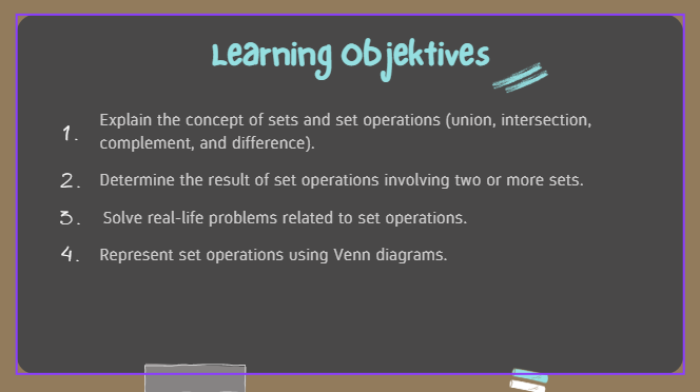
SET OPERATIONS
[b][size=200][u][i]STUDENT WORKSHEET[/i][/u][/size][/b]

[b][size=150][size=200]LITERATION[/size][/size][/b][br] [justify] According to its history, mathematical set theory began to be known since the end of the 19th century AD, but at the beginning of its emergence the concept of sets was still a matter ofdebate until finally in 1920 AD the concept of sets became one of the subjects in mathematics.1 Set theory was introduced by a German mathematician Georg Cantor (1918).[br][br] Georg Cantor is a mathematician who earned the nickname Father of Sets, because he was the first to contribute in developing set theory, especially his ideas in developing infinite set theory. A person who earned the nickname as the Father of the Set has the full name Georg Ferdinan Ludwig Philipp Cantor.M Born in Russia precisely in the city of St. Petersburg, March 03, 1845 and died at the age of 73 in Germany[br]precisely in the city of Halle, January 06, 1918.[br][br] According to his idea, a set is a set of objects that have certain and clear conditions. Which then these objects can be objects, numbers and so on which are hereinafter referred to as elements or members of a set. Elements of a set must be clearly defined because to distinguish which are members of a himpuna and which are not members of the set, which is hereinafter referred to as clearly defined.[br][br] Based on the idea of a father of the set above, it can be concluded that the set is a collection of clearly defined objects, which is then used as the definition of the set. Because if it is not clearly defined the collection is just a collection and not a set.[/justify]
[size=150][b]Instructions for Using the Learner Worksheet[br][/b][list=1][*][size=150]Read each clue carefully before doing the problem.[/size][/*][*][size=150]Work through each section in order for a more systematic understanding.[/size][/*][*][size=150]Discuss with your friends or teacher if there are difficulties in understanding the concepts.[/size][/*][*][size=150]Write the answers clearly and neatly.[/size][/*][/list][/size]
[b][size=200]LEARNING MEDIA[/size][/b]
[b][size=200]LEARNING ACTIVITIES[/size][/b][size=150][br]Let's Determine![br][math]A=\left\{\text{2,4,6,8,10}\right\}[/math][br][math]B=\left\{4,8,12,16\right\}[/math][br][math]S=\left\{\text{2,4,6,8,10,12,14,16}\right\}[/math][/size] (universe set)[br][br][size=150][size=200][b]TASK:[/b][/size][/size]
1. Determine the result of the following set operations:[br][list=1][list][*][math]A\cup B=...[/math][/*][*][math]A\cap B=...[/math][/*][*][math]A-B=...[/math][/*][*][math]A^C[/math] in the set universe [math]S[/math] is[/*][/list][/list]
2. Explain how to get the result of each operation above.
3. Determine the result of [math]\left(A-B\right)\cup\left(B-A\right)[/math]! What is the name of this operation?
4. Is the following statement true?[br][br] "All members [math]\left(A\cap B\right)[/math]are even numbers in the universe [math]S[/math]."[br][br] If true, give us a reason why!
5. Which has more members: [math]\left(A\cup B\right)[/math]or [math]\left(A\cap B\right)[/math] ? Explain!
6. Determine [math]\left(A\cap B\right)'[/math]! Then explain what it means in the context of the set universe!
7. Determine the result of:[br] [math]S-\left(A\cap B\right)[/math][br] [math]S-\left(A\cup B\right)[/math]
[size=150][b][size=200]Let's Observe![/size][br][/b]1. Draw a Venn diagram for the following operations: [br][math]-A\cup B[/math][br][math]-A\cap B[/math][/size][br]2. Observe which parts are included in each set operation.[br]3. Discuss with a friend whether there are any errors or differences in the results obtained.
[b][size=200]Let's Summarize![br][/size][/b]Based on the results of the previous activity, answer the following questions:[list=1][*]What conclusions can you draw about the operations of join, intersection, difference, and complement on sets?[/*][*]How does a Venn diagram help you understand the concept of set operations?[/*][*][justify]Name an example of the application of set operations in everyday life.[/justify][/*][/list]
[b][size=200]REFLECTION[/size][br][/b][size=100]Answer the following questions to reflect on your understanding:[br] 1. What new things did you learn from this activity? [br] 2. Which parts did you find easiest and most difficult?[br] 3. How can the concept of set operations be used in everyday life? [/size]